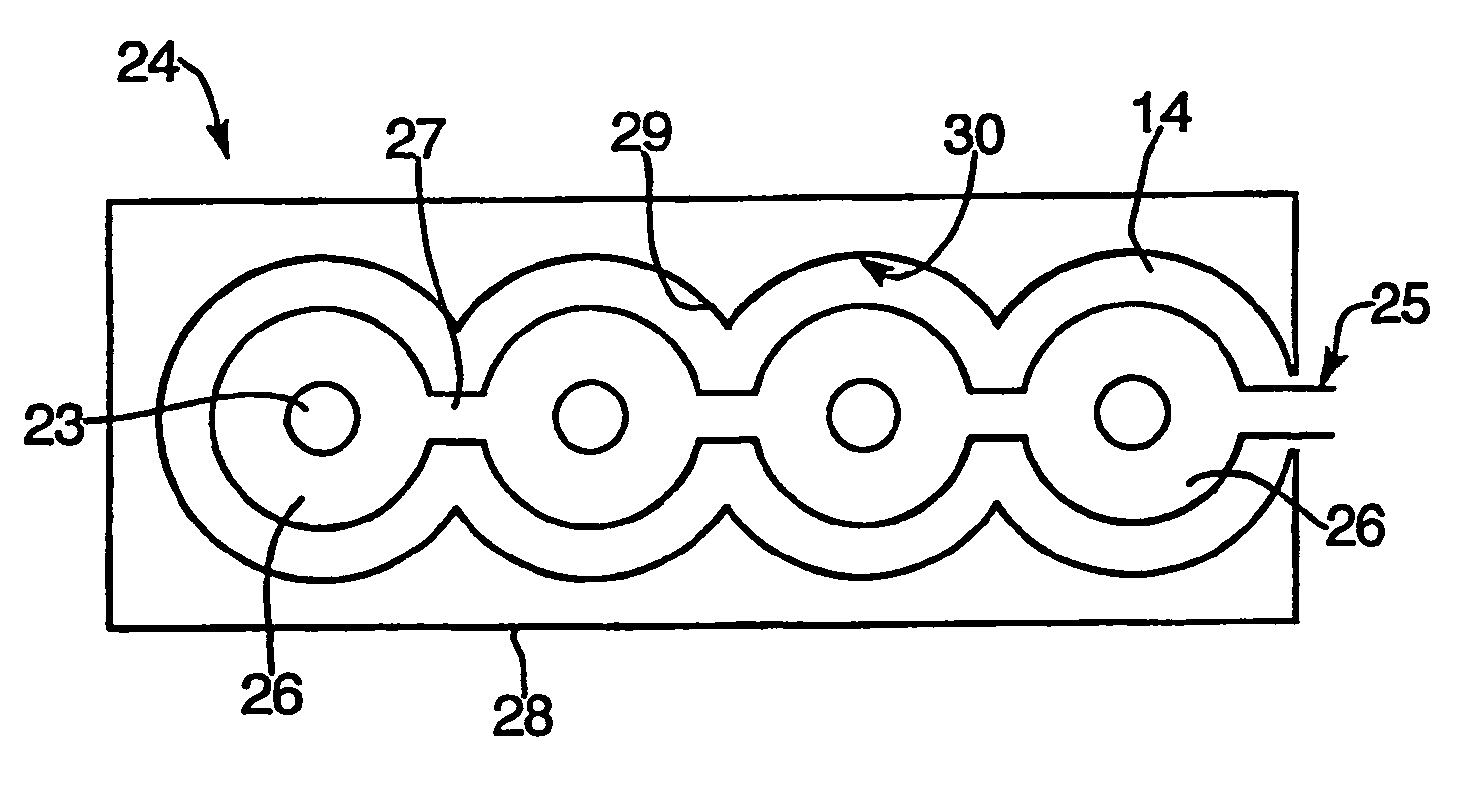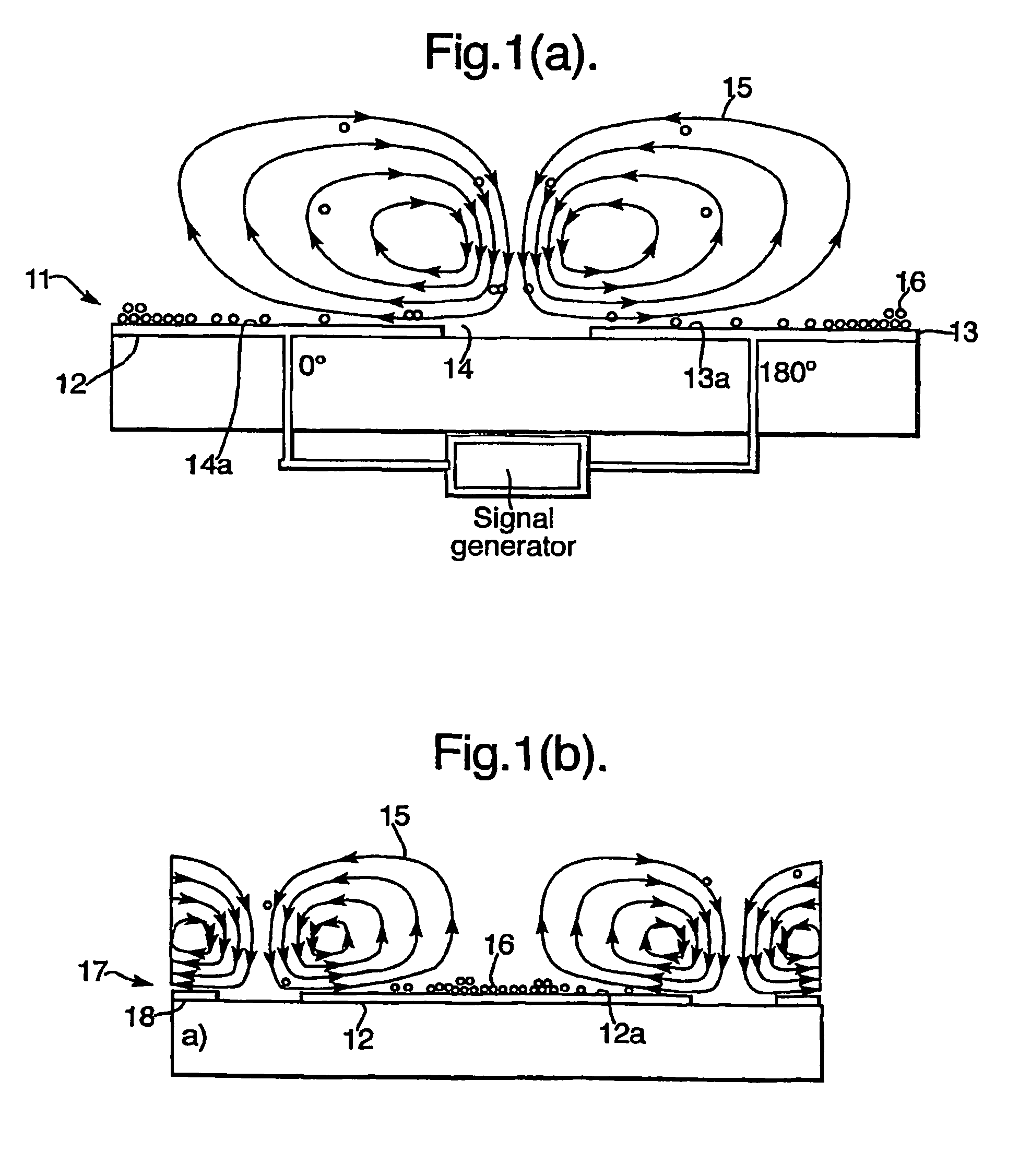Apparatus for collecting particles
a technology for collecting particles and apparatuses, which is applied in the direction of fluorescence/phosphorescence, liquid/fluent solid measurement, peptides, etc., can solve the problems of limited technique sensitivity, the area of greatest electric field inhomogeneity is at the electrode edge, and the diffusion of particles in liquid to the sensor surfa
- Summary
- Abstract
- Description
- Claims
- Application Information
AI Technical Summary
Benefits of technology
Problems solved by technology
Method used
Image
Examples
example 2
[0066]The electrode configuration 37 of FIG. 3, in which the circular surfaces 42 of each electrode 38, 39 are 575 μm and the gap size is 100 μm, is used to focus spores 16 of bacillus globiggi (˜800 nm) from a 30 mS / m potassium chloride solution containing ˜105 spores / ml at an applied alternating potential difference of 1 kHz frequency at 10V.
[0067]The number of spores 16 observed at 15 second intervals in the centre of a circular surface is examined under a high magnification microscope at various time intervals.
[0068]FIG. 4b) shows that in the absence of the applied potential difference sixteen spores 16 are present. After the application of the potential difference for 180 seconds the number is 113 and rises to 215 after 405 seconds. FIG. 5a) shows the rise in spore number plotted against time.
[0069]The electrode configuration of FIG. 3 clearly increases the local concentration of spores by collecting them on the electrode surface 42. It is expected that optimisation of paramete...
example 3
[0072]The electrode configuration 37 of FIG. 3, in which the circular surfaces 42 of each electrode 38, 39 are 230 μm and the gap size is 55 μm, is used to focus spores of bacillus globigii (˜800 μm) from a 10 mS / m potassium chloride solution at an applied alternating potential difference of varying frequency at 10V.
[0073]FIG. 5b) shows a plot of the distance of the collection front from the edge of the circle as a function of frequency. As may be seen at the vortices are larger at lower frequencies.
example 4
[0074]The electrode configuration of FIG. 3, in which the circular surfaces 42 of each electrode 38, 39 are 575 μm and the gap size is 100 μm, is used to focus fluorescent latex beads of 110 nm diameter from a 1 mS / m potassium chloride solution at an applied alternating potential difference of 10V at 600 Hz frequency.
[0075]Referring now to FIG. 6, in the absence of the applied potential difference a transmitted light photograph is not instructive. However, after 60 seconds and 120 seconds, fluorescence from the beads clearly shows them concentrated in the middle of the surfaces 42. The area at the top of the bus bar shows only background fluorescence of randomly distributed particles.
[0076]The concentration of virus size particles is an encouraging result in view of the fact that viruses may be smaller than other particles and therefore more likely to recirculated with the bulk flow. However, an antibody coating or layer capable of binding viruses would mitigate this effect.
PUM
| Property | Measurement | Unit |
|---|---|---|
| Electrical conductivity | aaaaa | aaaaa |
| Diameter | aaaaa | aaaaa |
| Diameter | aaaaa | aaaaa |
Abstract
Description
Claims
Application Information
 Login to View More
Login to View More - R&D
- Intellectual Property
- Life Sciences
- Materials
- Tech Scout
- Unparalleled Data Quality
- Higher Quality Content
- 60% Fewer Hallucinations
Browse by: Latest US Patents, China's latest patents, Technical Efficacy Thesaurus, Application Domain, Technology Topic, Popular Technical Reports.
© 2025 PatSnap. All rights reserved.Legal|Privacy policy|Modern Slavery Act Transparency Statement|Sitemap|About US| Contact US: help@patsnap.com



